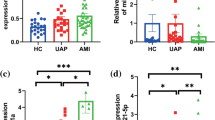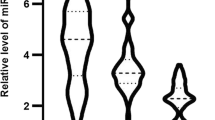Abstract
Objective
This study aimed to investigate the potential of microRNA (miR)-146a and miR-146b for predicting restenosis and rapid angiographic stenotic progression (RASP) risk in coronary heart disease (CHD) patients who underwent percutaneous coronary intervention (PCI) with drug-eluting stent (DES) implantation.
Methods
In total, 255 CHD patients who underwent PCI with DES were enrolled, and their baseline, procedural, and post procedure characteristics were recorded. Plasma samples were obtained before PCI treatment to detect the miR-146a and miR-146b expression by reverse transcription quantitative polymerase chain reaction. Besides, restenosis and RASP occurrences were assessed based on coronary angiograms at 12 months after the surgery.
Results
The occurrence rates of restenosis and RASP were 9.0% and 32.9% respectively in CHD patients who underwent PCI with DES. Furthermore, miR-146a and miR-146b expressions were elevated in CHD patients with restenosis compared with CHD patients without restenosis. Subsequent receiver operating characteristic (ROC) curve analysis showed that miR-146a (area under the curve (AUC), 0.674; 95% CI, 0.567-0.781) and miR-146b (AUC, 0.801; 95% CI, 0.729-0.875) could predict increased restenosis risk, among which miR-146b numerically exhibited a better predictive value for higher restenosis risk. Besides, miR-146a and miR-146b expressions were raised in CHD patients with RASP compared with CHD patients without RASP. Followed ROC curve analysis illuminated that miR-146a (AUC, 0.772; 95% CI, 0.714-0.829) and miR-146b (AUC, 0.706; 95% CI, 0.644-0.769) presented similar values in predicting elevated RASP risk.
Conclusion
miR-146a and miR-146b predict increased restenosis and RASP risk in CHD patients who underwent PCI with DES.




Similar content being viewed by others
References
Cassar A, Holmes DR Jr, Rihal CS, Gersh BJ (2009) Chronic coronary artery disease: diagnosis and management. Mayo Clin Proc 84(12):1130-1146. https://doi.org/10.4065/mcp.2009.0391
Cagle SD Jr, Cooperstein N (2018) Coronary artery disease: diagnosis and management. Prim Care 45(1):45-61. https://doi.org/10.1016/j.pop.2017.10.001
Wu Y, Fu X (2019) Comprehensive analysis of predictive factors for rapid angiographic stenotic progression and restenosis risk in coronary artery disease patients underwent percutaneous coronary intervention with drug-eluting stents implantation. J Clin Lab Anal 33(2):e22666. https://doi.org/10.1002/jcla.22666
Trikalinos TA, Alsheikh-Ali AA, Tatsioni A, Nallamothu BK, Kent DM (2009) Percutaneous coronary interventions for non-acute coronary artery disease: a quantitative 20-year synopsis and a network meta-analysis. Lancet 373(9667):911-918. https://doi.org/10.1016/S0140-6736(09)60319-6
Xiu WJ, Yang HT, Zheng YY, Ma YT, Xie X (2018) Drug-eluting balloons versus second-generation drug-eluting stents for treating in-stent restenosis in coronary heart disease after PCI: a meta-analysis. Cardiol Res Pract 2018:7658145. https://doi.org/10.1155/2018/7658145
Dangas GD, Claessen BE, Caixeta A, Sanidas EA, Mintz GS, Mehran R (2010) In-stent restenosis in the drug-eluting stent era. J Am Coll Cardiol 56(23):1897-1907. https://doi.org/10.1016/j.jacc.2010.07.028
Testa U, Pelosi E, Castelli G, Labbaye C (2017) miR-146 and miR-155: two key modulators of immune response and tumor development. Noncoding RNA 3(3). https://doi.org/10.3390/ncrna3030022
Paterson MR, Kriegel AJ (2017) MiR-146a/b: a family with shared seeds and different roots. Physiol Genomics 49(4):243-252. https://doi.org/10.1152/physiolgenomics.00133.2016
Li JW, He SY, Feng ZZ, Zhao L, Jia WK, Liu P, Zhu Y, Jian Z, Xiao YB (2015) MicroRNA-146b inhibition augments hypoxia-induced cardiomyocyte apoptosis. Mol Med Rep 12(5):6903-6910. https://doi.org/10.3892/mmr.2015.4333
Wang H, Jiang M, Xu Z, Huang H, Gong P, Zhu H, Ruan C (2015) miR-146b-5p promotes VSMC proliferation and migration. Int J Clin Exp Pathol 8(10):12901-12907
Nakachi T, Kosuge M, Hibi K, Ebina T, Hashiba K, Mitsuhashi T, Endo M, Umemura S, Kimura K (2008) C-reactive protein elevation and rapid angiographic progression of nonculprit lesion in patients with non-ST-segment elevation acute coronary syndrome. Circ J 72(12):1953-1959. https://doi.org/10.1253/circj.cj-08-0185
Inoue T, Croce K, Morooka T, Sakuma M, Node K, Simon DI (2011) Vascular inflammation and repair: implications for re-endothelialization, restenosis, and stent thrombosis. JACC Cardiovasc Interv 4(10):1057-1066. https://doi.org/10.1016/j.jcin.2011.05.025
Gao M, Wang X, Zhang X, Ha T, Ma H, Liu L, Kalbfleisch JH, Gao X, Kao RL, Williams DL, Li C (2015) Attenuation of cardiac dysfunction in polymicrobial sepsis by microRNA-146a is mediated via targeting of IRAK1 and TRAF6 expression. J Immunol 195(2):672-682. https://doi.org/10.4049/jimmunol.1403155
Takahashi Y, Satoh M, Minami Y, Tabuchi T, Itoh T, Nakamura M (2010) Expression of miR-146a/b is associated with the toll-like receptor 4 signal in coronary artery disease: effect of renin-angiotensin system blockade and statins on miRNA-146a/b and toll-like receptor 4 levels. Clin Sci (Lond) 119(9):395-405. https://doi.org/10.1042/CS20100003
Levine GN, Bates ER, Blankenship JC, Bailey SR, Bittl JA, Cercek B, Chambers CE, Ellis SG, Guyton RA, Hollenberg SM, Khot UN, Lange RA, Mauri L, Mehran R, Moussa ID, Mukherjee D, Nallamothu BK, Ting HH, American College of Cardiology F, American Heart Association Task Force on Practice G, Society for Cardiovascular A, Interventions (2013) 2011 ACCF/AHA/SCAI guideline for percutaneous coronary intervention: a report of the American College of Cardiology Foundation/American Heart Association Task Force on Practice Guidelines and the Society for Cardiovascular Angiography and Interventions. Catheter Cardiovasc Interv 82(4):E266-E355. https://doi.org/10.1002/ccd.23390
Grundeken MJ, Ishibashi Y, Genereux P, LaSalle L, Iqbal J, Wykrzykowska JJ, Morel MA, Tijssen JG, de Winter RJ, Girasis C, Garcia-Garcia HM, Onuma Y, Leon MB, Serruys PW (2015) Inter-core lab variability in analyzing quantitative coronary angiography for bifurcation lesions: a post-hoc analysis of a randomized trial. JACC Cardiovasc Interv 8(2):305-314. https://doi.org/10.1016/j.jcin.2014.12.002
Bruining N, Sabate M, de Feyter PJ, Kay IP, Ligthart J, Disco C, Kutryk MJ, Roelandt JR, Serruys PW (1999) Quantitative measurements of in-stent restenosis: a comparison between quantitative coronary ultrasound and quantitative coronary angiography. Catheter Cardiovasc Interv 48(2):133-142
Jian W, Li L, Wei XM, Wu CQ, Gui C (2019) Prognostic value of angiopoietin-2 for patients with coronary heart disease after elective PCI. Medicine (Baltimore) 98(5):e14216. https://doi.org/10.1097/MD.0000000000014216
Casas JP, Shah T, Hingorani AD, Danesh J, Pepys MB (2008) C-reactive protein and coronary heart disease: a critical review. J Intern Med 264(4):295-314. https://doi.org/10.1111/j.1365-2796.2008.02015.x
Schillinger M, Minar E (2005) Restenosis after percutaneous angioplasty: the role of vascular inflammation. Vasc Health Risk Manag 1(1):73-78. https://doi.org/10.2147/vhrm.1.1.73.58932
Bukauskas T, Mickus R, Cereskevicius D, Macas A (2019) Value of serum miR-23a, miR-30d, and miR-146a biomarkers in ST-elevation myocardial infarction. Med Sci Monit 25:3925-3932. https://doi.org/10.12659/MSM.913743
Raitoharju E, Lyytikainen LP, Levula M, Oksala N, Mennander A, Tarkka M, Klopp N, Illig T, Kahonen M, Karhunen PJ, Laaksonen R, Lehtimaki T (2011) miR-21, miR-210, miR-34a, and miR-146a/b are up-regulated in human atherosclerotic plaques in the Tampere Vascular Study. Atherosclerosis 219(1):211-217. https://doi.org/10.1016/j.atherosclerosis.2011.07.020
Dong S, Xiong W, Yuan J, Li J, Liu J, Xu X (2013) MiRNA-146a regulates the maturation and differentiation of vascular smooth muscle cells by targeting NF-kappaB expression. Mol Med Rep 8(2):407-412. https://doi.org/10.3892/mmr.2013.1538
Sun SG, Zheng B, Han M, Fang XM, Li HX, Miao SB, Su M, Han Y, Shi HJ, Wen JK (2011) miR-146a and Kruppel-like factor 4 form a feedback loop to participate in vascular smooth muscle cell proliferation. EMBO Rep 12(1):56-62. https://doi.org/10.1038/embor.2010.172
Lee HM, Kim TS, Jo EK (2016) MiR-146 and miR-125 in the regulation of innate immunity and inflammation. BMB Rep 49(6):311-318. https://doi.org/10.5483/bmbrep.2016.49.6.056
Author information
Authors and Affiliations
Corresponding author
Ethics declarations
All procedures performed in this study were in accordance with the ethical standards of the institutional and/or national research committee and with the 1964 Helsinki declaration and its later amendments or comparable ethical standards. The Institutional Review Board of Linqing People’s Hospital approved this study.
Conflict of interest
The authors declare that they have no conflict of interest.
Additional information
Publisher’s note
Springer Nature remains neutral with regard to jurisdictional claims in published maps and institutional affiliations.
Rights and permissions
About this article
Cite this article
Zhang, H., Zhang, Q., Liu, Y. et al. miR-146a and miR-146b predict increased restenosis and rapid angiographic stenotic progression risk in coronary heart disease patients who underwent percutaneous coronary intervention. Ir J Med Sci 189, 467–474 (2020). https://doi.org/10.1007/s11845-019-02101-9
Received:
Accepted:
Published:
Issue Date:
DOI: https://doi.org/10.1007/s11845-019-02101-9




